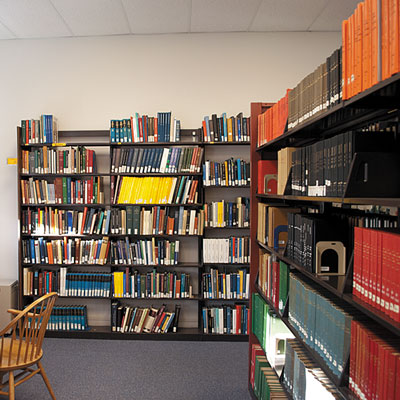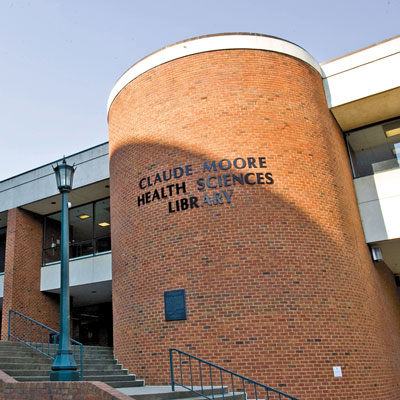Next Chapter
You might think the growth of online resources has made UVA’s 14 libraries less relevant to student life. Think again.
A library has always been at the heart of the University of Virginia. When Thomas Jefferson designed his Academical Village, he placed a library—rather than a church, which was the practice at the time—in the center. Housed in the Rotunda, that collection grew from 8,000 books at its founding to 56,733 before the 1895 fire gutted it by more than two-thirds. It was a major intellectual loss to the University.
It wasn’t until the mid-20th century that the UVA Library rebuilt its collection, eventually moving across the street from the restored Rotunda to Alderman Library in 1938. Housed within it was the Tracy W. McGregor Library, a special collections archive that put UVA on the map as a research library.

Today the library encompasses nearly 8 million books and other media spread across 14 libraries. The McGregor collection moved to become part of the manuscripts, rare books and artifacts in the nearby Albert and Shirley Small Special Collections Library. The room in Alderman that once housed it, now known affectionately as the “Harry Potter Room,” serves as a quiet reading and study space for students. The windows, once shuttered to protect delicate artifacts, now let in sunlight, along with a view of camellia blossoms. These moves—from the Rotunda to Alderman in 1938 and the repurposing of the McGregor Room—show how spaces have shifted within the libraries as student use of the collections has changed. And it will continue to change. The circulation of printed materials has steadily declined in the past few decades, while the use of electronic resources has soared, matching trends at libraries across the country. UVA Library’s collection of online digital materials, now at more than 22 million items, continues to grow. In surveys, the majority of faculty and graduate students report that they use physical and electronic materials from the library weekly, while the majority of undergraduates say they use those materials only occasionally. However, undergraduates physically visit the libraries far more frequently than any other group and rely on them as their central places to study and focus. As the library administration looks to the future, it will seek to balance these needs—keeping materials accessible while expanding study and digital spaces.
John Unsworth (Grad ’88), the recently appointed University Librarian, looks at the whole of the system’s resources and says he is “not at all worried about the future of libraries. … [Our] print collection is going to continue to grow. But it’s also inevitable that, as a percentage, its use will probably be smaller and smaller over time compared to electronic resources.” Often, he says, the use of electronic material happens outside the physical libraries, but it happens because of librarians. “It happens because somebody acquired and organized and made that material accessible,” he says. “The most important thing you find in a library is a librarian, and the need for people with expertise in the field of information isn’t going to go away.”

The director of UVA’s Institute for Advanced Technology in the Humanities (IATH) from 1993 to 2003, Unsworth has been an advocate for the digital humanities—a scholarly field that brings together humanities disciplines with computing and collaborative research—and the open sharing of information throughout his career. One of his goals as University Librarian is to work with other libraries to build what he calls “research sharing consortiums,” making information free and accessible online.
When he returned to UVA in 2016, Unsworth brought several such projects with him, including one that grants online access to 4 billion pages of materials from the country’s major research libraries. “There are interesting, important things that libraries can do collectively that no one library can do alone,” he says.
Along with linking UVA to research and data partnerships, Unsworth also plans to better coordinate work between IATH and the UVA Scholars’ Lab so that UVA’s digital humanities work “can have more of a national impact.”
And perhaps the library system’s most ambitious goal is a proposed $160 million renovation of Alderman Library, to be funded by the state and through donations, and expected to last six to 10 years in phases so that the library is never closed to the public. The project is still in its planning stages; a study by the consulting firm Brightspot is currently underway. The firm is interviewing students and faculty about how best to use the library’s space and how many books need to be immediately accessible. It will be a year before Unsworth and his team will have the timetable and know other details.
One likely outcome will be the repurposing of some stacks space for other uses—study spaces, meeting rooms, labs and research areas. During the renovation, Unsworth says, all of the 2.5 million books currently housed in the library will be moved to Ivy Stacks, a storage space on Ivy Road from which books can be requested and produced within a day. Unsworth is working with a graduate student to research the history of the collection and will have discussions with the library’s acquisition team as well as University faculty to determine which books will return to Alderman. “We want faculty and students to identify the characteristics that they want to see in the collections on open shelves,” he says. “The question is not how many, but which books should be in Alderman.”
What will not change is the role libraries play in the UVA student experience and, especially for undergraduates, the importance of their physical place. In the 2016 library user survey of 650 undergraduate students, 73 percent said the library helps them study and work more efficiently. The newest space in the library system is, fittingly, the Dome Room of the restored Rotunda, where students can study, browse books by UVA-affiliated authors or cram for exams late into the night.
“For many students, the library is the place they go when they want to get work done,” says Donna Tolson, the library’s senior director of administration and planning. “I hesitate to use the word ‘religious,’” she says about the students’ relationships to the library’s rooms, “but it’s the way they organize their effort. And we have made space for them to do that.”
Take a look at the library spaces across Grounds—old, new and repurposed. No studying was harmed in the making of this photo essay.







Stacks and Figures
Physics 

Smaller departmental libraries like the Physics, Mathematics and Music libraries may close over the next decade, says Library Dean John Unsworth. “In terms of being able to provide access for long hours and having the service point manned, there are all kinds of practical reasons why it makes sense to consolidate.”
1,263
Items Lent
26,005
Collection size
Special Collections 

In addition to the rare books and artifacts counted below, the Albert and Shirley Small Special Collections Library holds 16 million manuscripts, including the papers of William Faulkner, now on exhibit on Grounds (see related story).
10,949
Items Lent
633,579
Collection size
(does not include manuscripts)
Source: UVA Libraries
Notes: The collection size represents physical collections only: printed volumes in each library, as well as graphic materials, sound recordings, videos, maps and microforms. Some libraries do not count their visitors. All statistics from 2015–16.












